Policy Critique: Management of Adverse Drug Events (ADE) Report
VerifiedAdded on 2020/03/01
|14
|3155
|64
Report
AI Summary
This report critically analyzes and compares two policies concerning the management of adverse drug events (ADEs): the Preventing adverse drug events Policy Guideline from the Government of South Australia and the National Action Plan for adverse drug event prevention by the U.S. Department of Health and Human Services. The report explores similarities, such as the emphasis on surveillance and the importance of documentation, communication, and patient information. However, it highlights key differences, including the National Action Plan's focus on evidence-based prevention techniques and its targeting of specific ADEs related to diabetes agents, anticoagulants, and opioids. The report emphasizes the National Action Plan's rigor, citing its organization, evidence-based practices, and focus on high-priority targets. The report also discusses the role of health information technology, such as CPOE and medical reconciliation, in managing ADEs. Ultimately, the report concludes that the National Action Plan is the more rigorous policy due to its comprehensive approach, evidence-based strategies, and proactive measures for preventing adverse drug events.
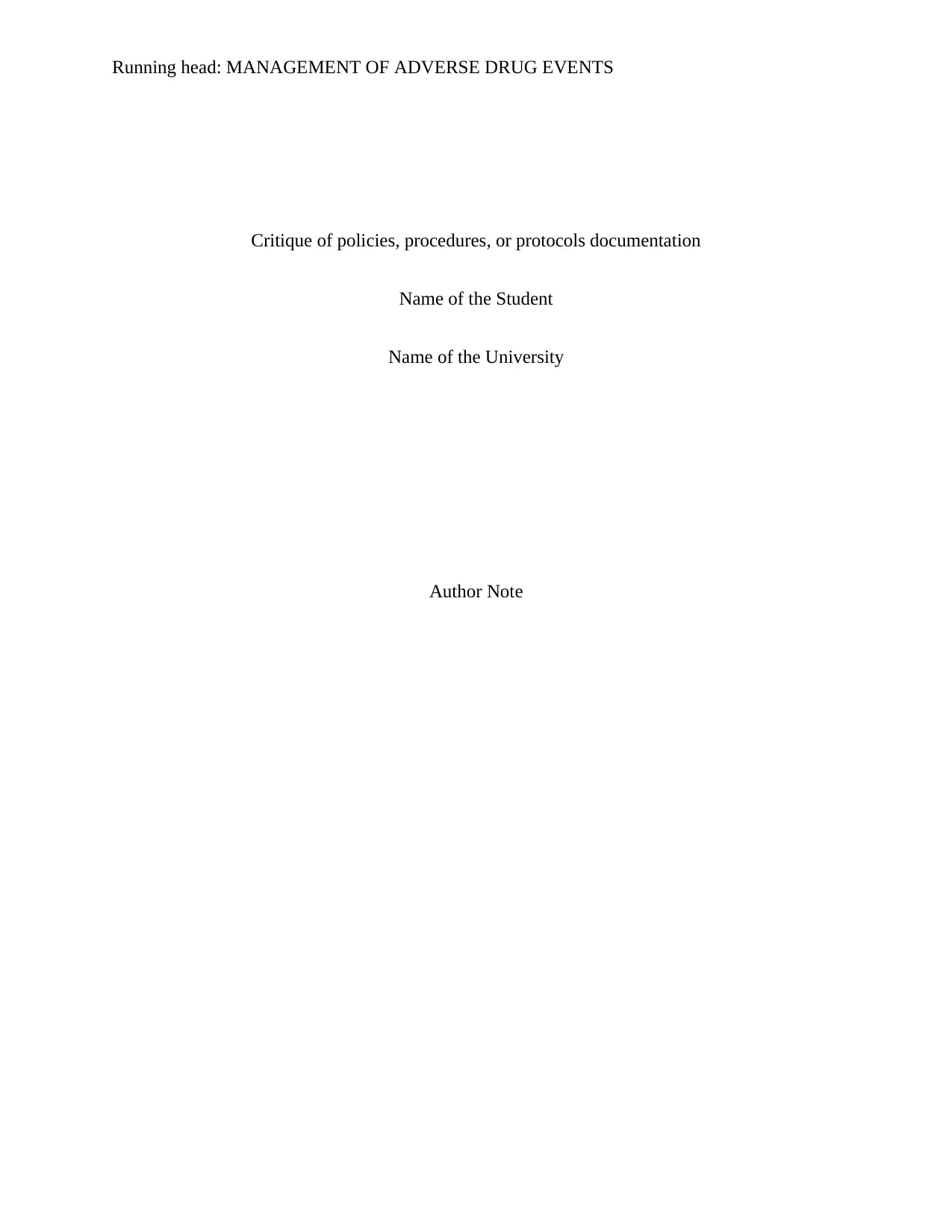
Running head: MANAGEMENT OF ADVERSE DRUG EVENTS
Critique of policies, procedures, or protocols documentation
Name of the Student
Name of the University
Author Note
Critique of policies, procedures, or protocols documentation
Name of the Student
Name of the University
Author Note
Secure Best Marks with AI Grader
Need help grading? Try our AI Grader for instant feedback on your assignments.
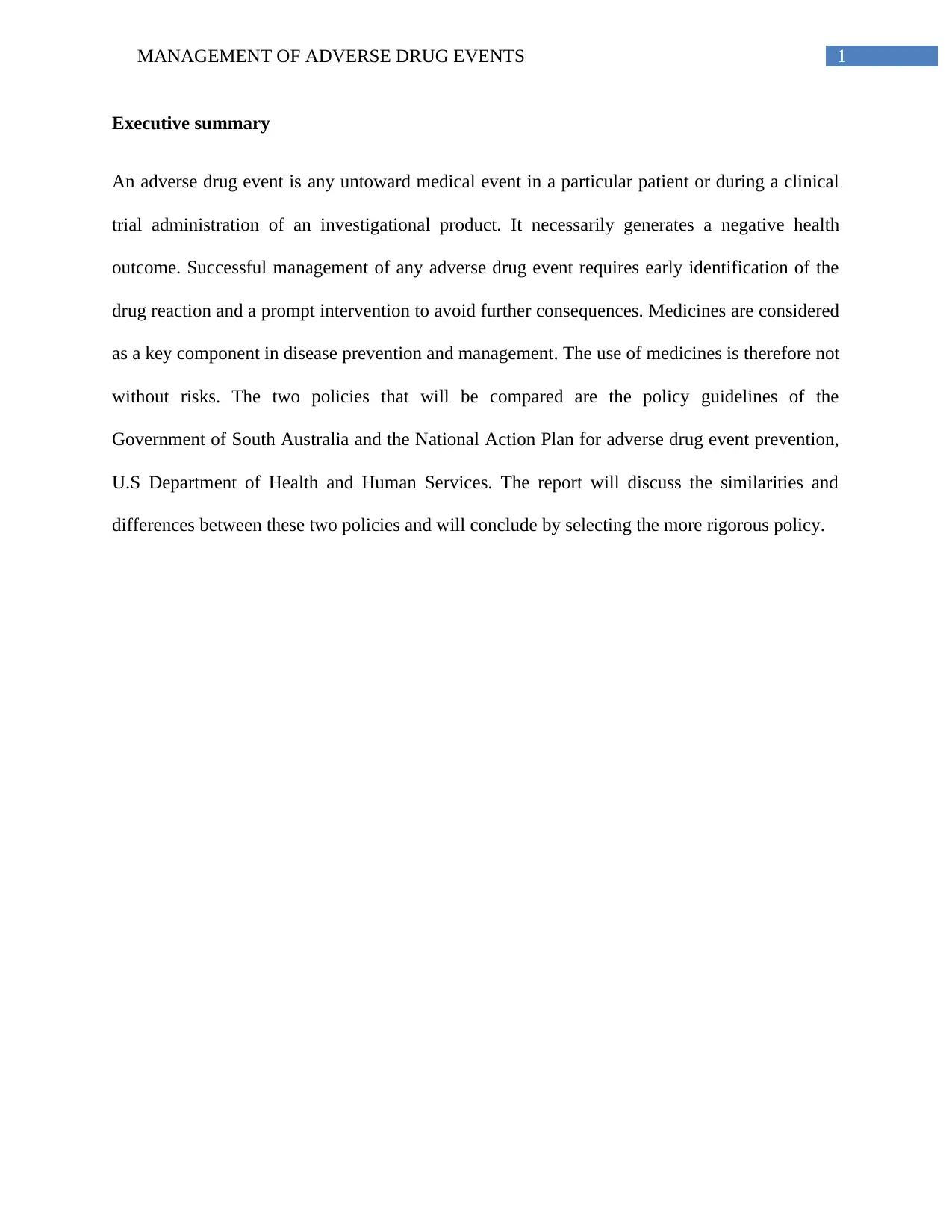
1MANAGEMENT OF ADVERSE DRUG EVENTS
Executive summary
An adverse drug event is any untoward medical event in a particular patient or during a clinical
trial administration of an investigational product. It necessarily generates a negative health
outcome. Successful management of any adverse drug event requires early identification of the
drug reaction and a prompt intervention to avoid further consequences. Medicines are considered
as a key component in disease prevention and management. The use of medicines is therefore not
without risks. The two policies that will be compared are the policy guidelines of the
Government of South Australia and the National Action Plan for adverse drug event prevention,
U.S Department of Health and Human Services. The report will discuss the similarities and
differences between these two policies and will conclude by selecting the more rigorous policy.
Executive summary
An adverse drug event is any untoward medical event in a particular patient or during a clinical
trial administration of an investigational product. It necessarily generates a negative health
outcome. Successful management of any adverse drug event requires early identification of the
drug reaction and a prompt intervention to avoid further consequences. Medicines are considered
as a key component in disease prevention and management. The use of medicines is therefore not
without risks. The two policies that will be compared are the policy guidelines of the
Government of South Australia and the National Action Plan for adverse drug event prevention,
U.S Department of Health and Human Services. The report will discuss the similarities and
differences between these two policies and will conclude by selecting the more rigorous policy.
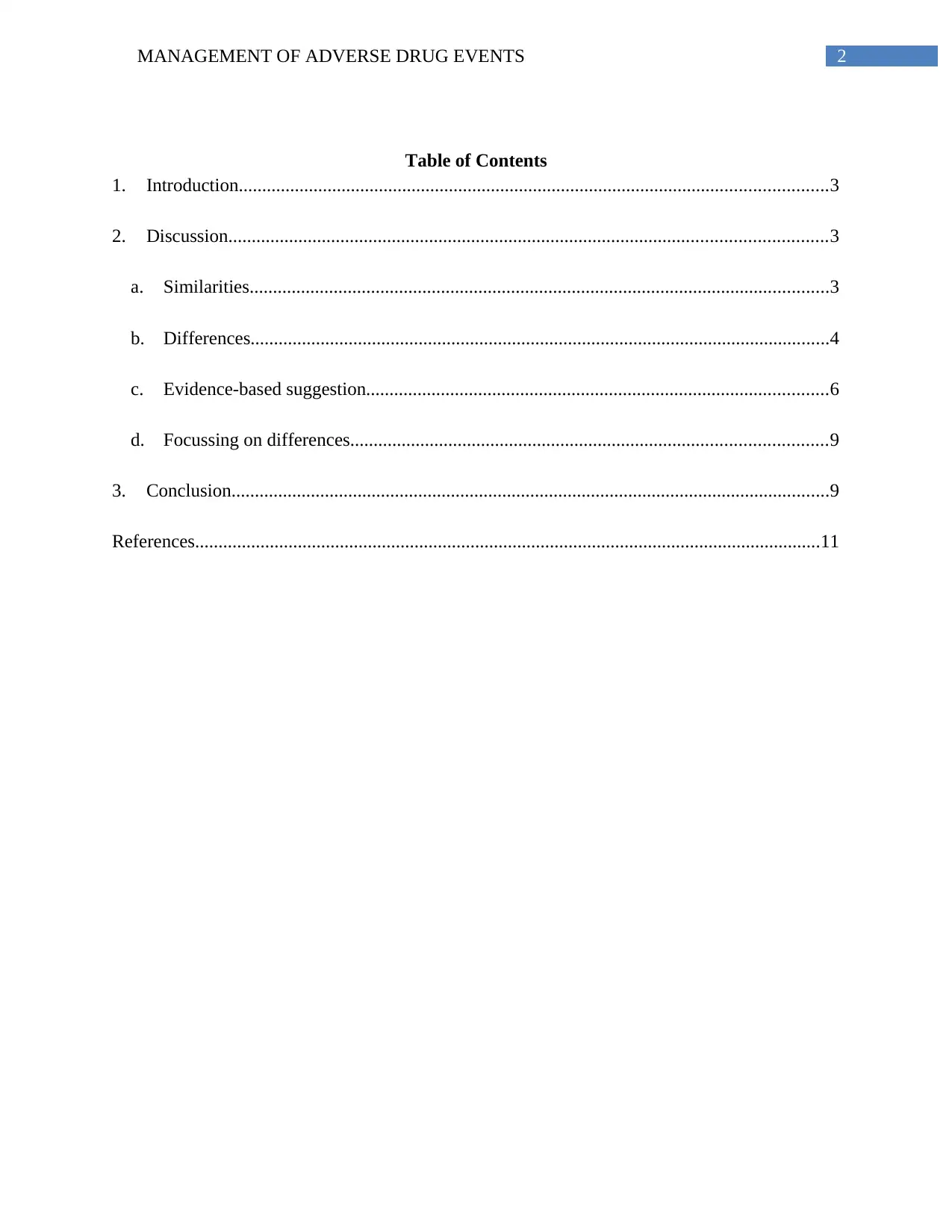
2MANAGEMENT OF ADVERSE DRUG EVENTS
Table of Contents
1. Introduction..............................................................................................................................3
2. Discussion................................................................................................................................3
a. Similarities............................................................................................................................3
b. Differences............................................................................................................................4
c. Evidence-based suggestion...................................................................................................6
d. Focussing on differences......................................................................................................9
3. Conclusion................................................................................................................................9
References......................................................................................................................................11
Table of Contents
1. Introduction..............................................................................................................................3
2. Discussion................................................................................................................................3
a. Similarities............................................................................................................................3
b. Differences............................................................................................................................4
c. Evidence-based suggestion...................................................................................................6
d. Focussing on differences......................................................................................................9
3. Conclusion................................................................................................................................9
References......................................................................................................................................11
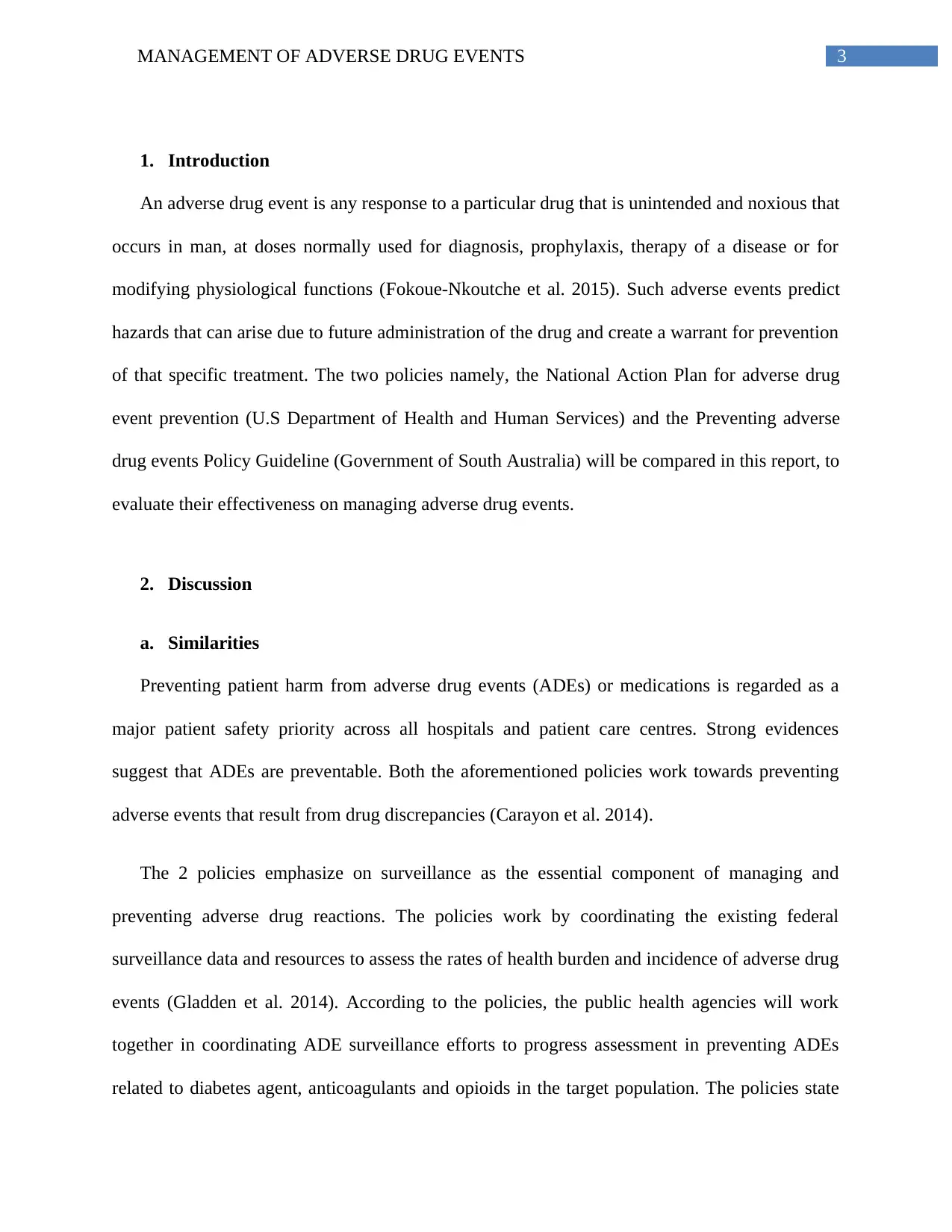
3MANAGEMENT OF ADVERSE DRUG EVENTS
1. Introduction
An adverse drug event is any response to a particular drug that is unintended and noxious that
occurs in man, at doses normally used for diagnosis, prophylaxis, therapy of a disease or for
modifying physiological functions (Fokoue-Nkoutche et al. 2015). Such adverse events predict
hazards that can arise due to future administration of the drug and create a warrant for prevention
of that specific treatment. The two policies namely, the National Action Plan for adverse drug
event prevention (U.S Department of Health and Human Services) and the Preventing adverse
drug events Policy Guideline (Government of South Australia) will be compared in this report, to
evaluate their effectiveness on managing adverse drug events.
2. Discussion
a. Similarities
Preventing patient harm from adverse drug events (ADEs) or medications is regarded as a
major patient safety priority across all hospitals and patient care centres. Strong evidences
suggest that ADEs are preventable. Both the aforementioned policies work towards preventing
adverse events that result from drug discrepancies (Carayon et al. 2014).
The 2 policies emphasize on surveillance as the essential component of managing and
preventing adverse drug reactions. The policies work by coordinating the existing federal
surveillance data and resources to assess the rates of health burden and incidence of adverse drug
events (Gladden et al. 2014). According to the policies, the public health agencies will work
together in coordinating ADE surveillance efforts to progress assessment in preventing ADEs
related to diabetes agent, anticoagulants and opioids in the target population. The policies state
1. Introduction
An adverse drug event is any response to a particular drug that is unintended and noxious that
occurs in man, at doses normally used for diagnosis, prophylaxis, therapy of a disease or for
modifying physiological functions (Fokoue-Nkoutche et al. 2015). Such adverse events predict
hazards that can arise due to future administration of the drug and create a warrant for prevention
of that specific treatment. The two policies namely, the National Action Plan for adverse drug
event prevention (U.S Department of Health and Human Services) and the Preventing adverse
drug events Policy Guideline (Government of South Australia) will be compared in this report, to
evaluate their effectiveness on managing adverse drug events.
2. Discussion
a. Similarities
Preventing patient harm from adverse drug events (ADEs) or medications is regarded as a
major patient safety priority across all hospitals and patient care centres. Strong evidences
suggest that ADEs are preventable. Both the aforementioned policies work towards preventing
adverse events that result from drug discrepancies (Carayon et al. 2014).
The 2 policies emphasize on surveillance as the essential component of managing and
preventing adverse drug reactions. The policies work by coordinating the existing federal
surveillance data and resources to assess the rates of health burden and incidence of adverse drug
events (Gladden et al. 2014). According to the policies, the public health agencies will work
together in coordinating ADE surveillance efforts to progress assessment in preventing ADEs
related to diabetes agent, anticoagulants and opioids in the target population. The policies state
Secure Best Marks with AI Grader
Need help grading? Try our AI Grader for instant feedback on your assignments.
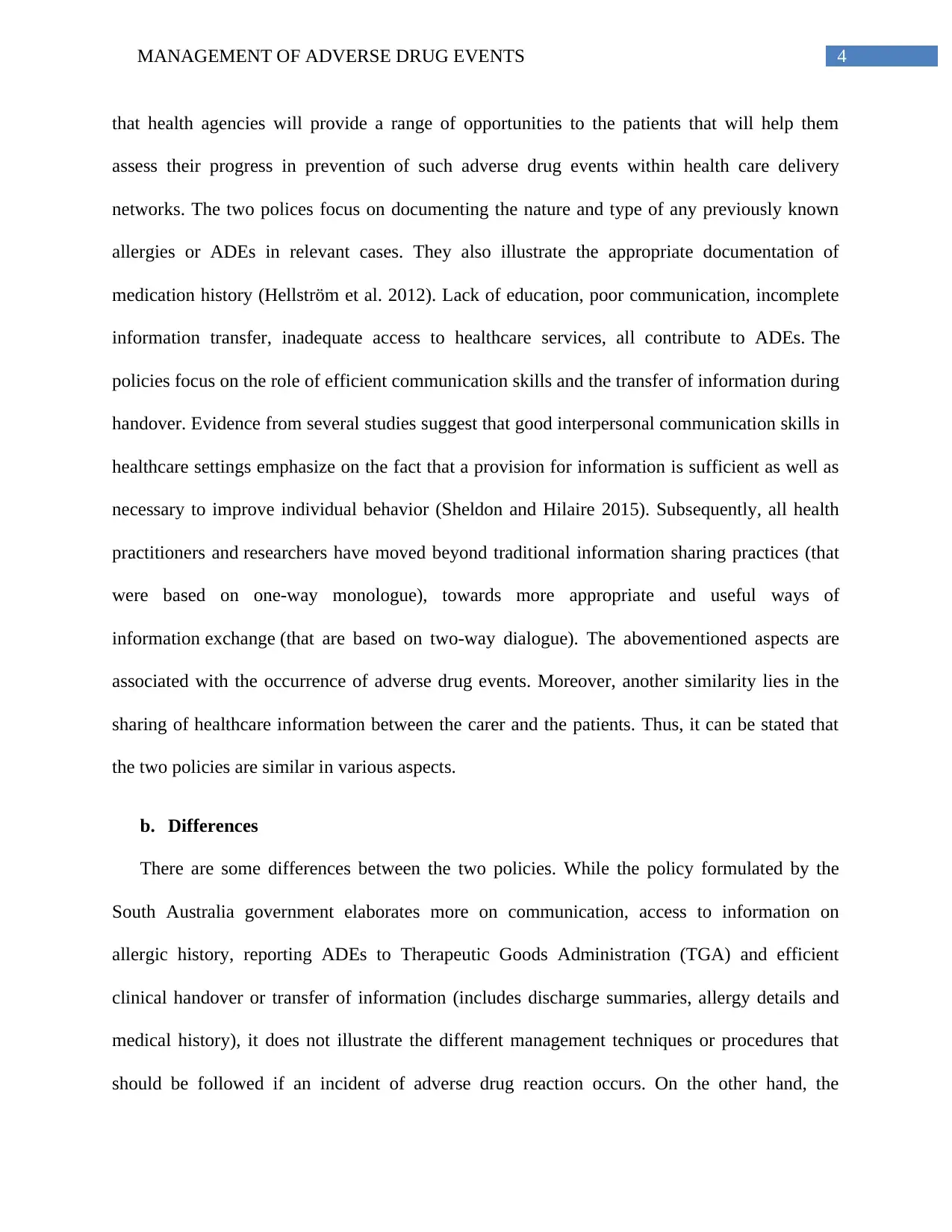
4MANAGEMENT OF ADVERSE DRUG EVENTS
that health agencies will provide a range of opportunities to the patients that will help them
assess their progress in prevention of such adverse drug events within health care delivery
networks. The two polices focus on documenting the nature and type of any previously known
allergies or ADEs in relevant cases. They also illustrate the appropriate documentation of
medication history (Hellström et al. 2012). Lack of education, poor communication, incomplete
information transfer, inadequate access to healthcare services, all contribute to ADEs. The
policies focus on the role of efficient communication skills and the transfer of information during
handover. Evidence from several studies suggest that good interpersonal communication skills in
healthcare settings emphasize on the fact that a provision for information is sufficient as well as
necessary to improve individual behavior (Sheldon and Hilaire 2015). Subsequently, all health
practitioners and researchers have moved beyond traditional information sharing practices (that
were based on one-way monologue), towards more appropriate and useful ways of
information exchange (that are based on two-way dialogue). The abovementioned aspects are
associated with the occurrence of adverse drug events. Moreover, another similarity lies in the
sharing of healthcare information between the carer and the patients. Thus, it can be stated that
the two policies are similar in various aspects.
b. Differences
There are some differences between the two policies. While the policy formulated by the
South Australia government elaborates more on communication, access to information on
allergic history, reporting ADEs to Therapeutic Goods Administration (TGA) and efficient
clinical handover or transfer of information (includes discharge summaries, allergy details and
medical history), it does not illustrate the different management techniques or procedures that
should be followed if an incident of adverse drug reaction occurs. On the other hand, the
that health agencies will provide a range of opportunities to the patients that will help them
assess their progress in prevention of such adverse drug events within health care delivery
networks. The two polices focus on documenting the nature and type of any previously known
allergies or ADEs in relevant cases. They also illustrate the appropriate documentation of
medication history (Hellström et al. 2012). Lack of education, poor communication, incomplete
information transfer, inadequate access to healthcare services, all contribute to ADEs. The
policies focus on the role of efficient communication skills and the transfer of information during
handover. Evidence from several studies suggest that good interpersonal communication skills in
healthcare settings emphasize on the fact that a provision for information is sufficient as well as
necessary to improve individual behavior (Sheldon and Hilaire 2015). Subsequently, all health
practitioners and researchers have moved beyond traditional information sharing practices (that
were based on one-way monologue), towards more appropriate and useful ways of
information exchange (that are based on two-way dialogue). The abovementioned aspects are
associated with the occurrence of adverse drug events. Moreover, another similarity lies in the
sharing of healthcare information between the carer and the patients. Thus, it can be stated that
the two policies are similar in various aspects.
b. Differences
There are some differences between the two policies. While the policy formulated by the
South Australia government elaborates more on communication, access to information on
allergic history, reporting ADEs to Therapeutic Goods Administration (TGA) and efficient
clinical handover or transfer of information (includes discharge summaries, allergy details and
medical history), it does not illustrate the different management techniques or procedures that
should be followed if an incident of adverse drug reaction occurs. On the other hand, the
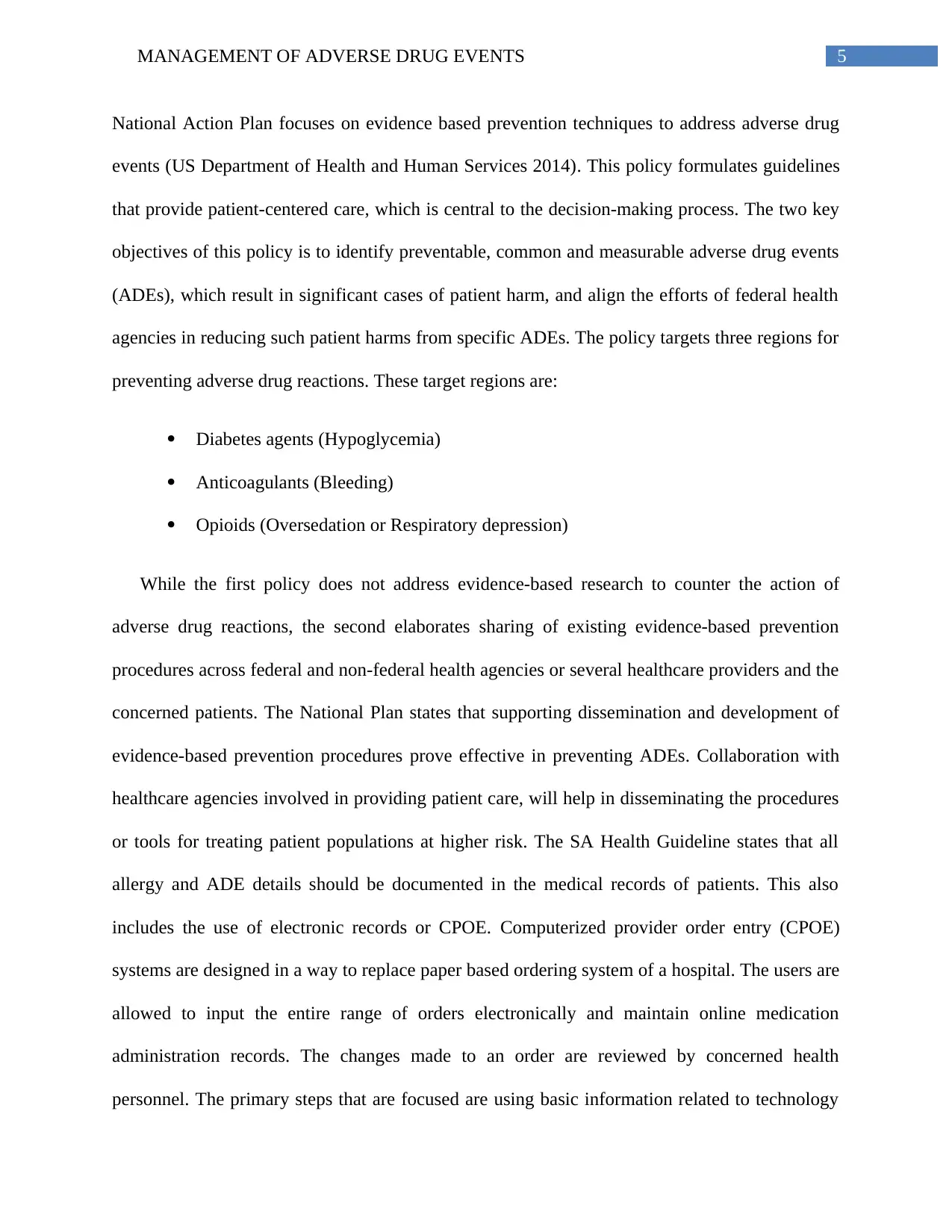
5MANAGEMENT OF ADVERSE DRUG EVENTS
National Action Plan focuses on evidence based prevention techniques to address adverse drug
events (US Department of Health and Human Services 2014). This policy formulates guidelines
that provide patient-centered care, which is central to the decision-making process. The two key
objectives of this policy is to identify preventable, common and measurable adverse drug events
(ADEs), which result in significant cases of patient harm, and align the efforts of federal health
agencies in reducing such patient harms from specific ADEs. The policy targets three regions for
preventing adverse drug reactions. These target regions are:
Diabetes agents (Hypoglycemia)
Anticoagulants (Bleeding)
Opioids (Oversedation or Respiratory depression)
While the first policy does not address evidence-based research to counter the action of
adverse drug reactions, the second elaborates sharing of existing evidence-based prevention
procedures across federal and non-federal health agencies or several healthcare providers and the
concerned patients. The National Plan states that supporting dissemination and development of
evidence-based prevention procedures prove effective in preventing ADEs. Collaboration with
healthcare agencies involved in providing patient care, will help in disseminating the procedures
or tools for treating patient populations at higher risk. The SA Health Guideline states that all
allergy and ADE details should be documented in the medical records of patients. This also
includes the use of electronic records or CPOE. Computerized provider order entry (CPOE)
systems are designed in a way to replace paper based ordering system of a hospital. The users are
allowed to input the entire range of orders electronically and maintain online medication
administration records. The changes made to an order are reviewed by concerned health
personnel. The primary steps that are focused are using basic information related to technology
National Action Plan focuses on evidence based prevention techniques to address adverse drug
events (US Department of Health and Human Services 2014). This policy formulates guidelines
that provide patient-centered care, which is central to the decision-making process. The two key
objectives of this policy is to identify preventable, common and measurable adverse drug events
(ADEs), which result in significant cases of patient harm, and align the efforts of federal health
agencies in reducing such patient harms from specific ADEs. The policy targets three regions for
preventing adverse drug reactions. These target regions are:
Diabetes agents (Hypoglycemia)
Anticoagulants (Bleeding)
Opioids (Oversedation or Respiratory depression)
While the first policy does not address evidence-based research to counter the action of
adverse drug reactions, the second elaborates sharing of existing evidence-based prevention
procedures across federal and non-federal health agencies or several healthcare providers and the
concerned patients. The National Plan states that supporting dissemination and development of
evidence-based prevention procedures prove effective in preventing ADEs. Collaboration with
healthcare agencies involved in providing patient care, will help in disseminating the procedures
or tools for treating patient populations at higher risk. The SA Health Guideline states that all
allergy and ADE details should be documented in the medical records of patients. This also
includes the use of electronic records or CPOE. Computerized provider order entry (CPOE)
systems are designed in a way to replace paper based ordering system of a hospital. The users are
allowed to input the entire range of orders electronically and maintain online medication
administration records. The changes made to an order are reviewed by concerned health
personnel. The primary steps that are focused are using basic information related to technology
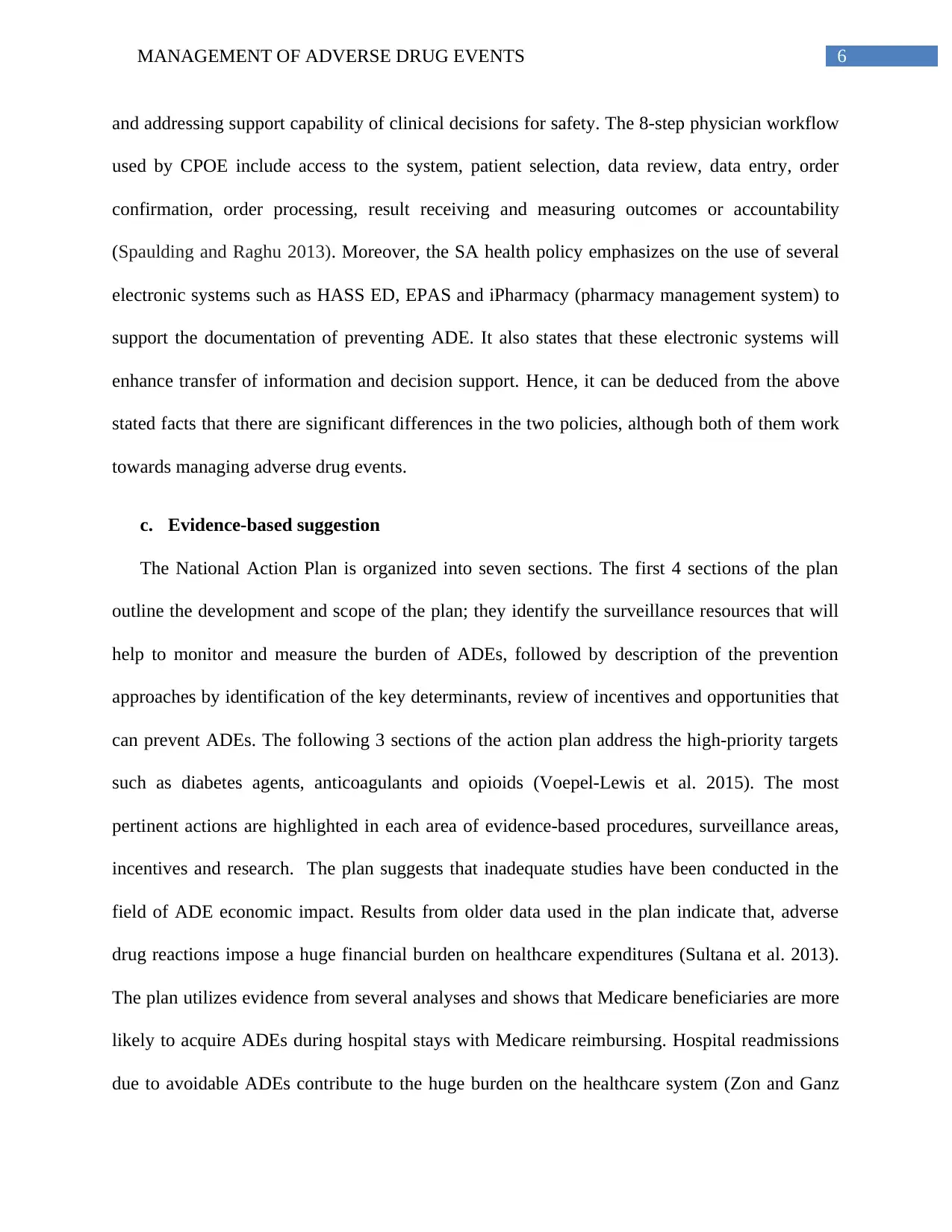
6MANAGEMENT OF ADVERSE DRUG EVENTS
and addressing support capability of clinical decisions for safety. The 8-step physician workflow
used by CPOE include access to the system, patient selection, data review, data entry, order
confirmation, order processing, result receiving and measuring outcomes or accountability
(Spaulding and Raghu 2013). Moreover, the SA health policy emphasizes on the use of several
electronic systems such as HASS ED, EPAS and iPharmacy (pharmacy management system) to
support the documentation of preventing ADE. It also states that these electronic systems will
enhance transfer of information and decision support. Hence, it can be deduced from the above
stated facts that there are significant differences in the two policies, although both of them work
towards managing adverse drug events.
c. Evidence-based suggestion
The National Action Plan is organized into seven sections. The first 4 sections of the plan
outline the development and scope of the plan; they identify the surveillance resources that will
help to monitor and measure the burden of ADEs, followed by description of the prevention
approaches by identification of the key determinants, review of incentives and opportunities that
can prevent ADEs. The following 3 sections of the action plan address the high-priority targets
such as diabetes agents, anticoagulants and opioids (Voepel-Lewis et al. 2015). The most
pertinent actions are highlighted in each area of evidence-based procedures, surveillance areas,
incentives and research. The plan suggests that inadequate studies have been conducted in the
field of ADE economic impact. Results from older data used in the plan indicate that, adverse
drug reactions impose a huge financial burden on healthcare expenditures (Sultana et al. 2013).
The plan utilizes evidence from several analyses and shows that Medicare beneficiaries are more
likely to acquire ADEs during hospital stays with Medicare reimbursing. Hospital readmissions
due to avoidable ADEs contribute to the huge burden on the healthcare system (Zon and Ganz
and addressing support capability of clinical decisions for safety. The 8-step physician workflow
used by CPOE include access to the system, patient selection, data review, data entry, order
confirmation, order processing, result receiving and measuring outcomes or accountability
(Spaulding and Raghu 2013). Moreover, the SA health policy emphasizes on the use of several
electronic systems such as HASS ED, EPAS and iPharmacy (pharmacy management system) to
support the documentation of preventing ADE. It also states that these electronic systems will
enhance transfer of information and decision support. Hence, it can be deduced from the above
stated facts that there are significant differences in the two policies, although both of them work
towards managing adverse drug events.
c. Evidence-based suggestion
The National Action Plan is organized into seven sections. The first 4 sections of the plan
outline the development and scope of the plan; they identify the surveillance resources that will
help to monitor and measure the burden of ADEs, followed by description of the prevention
approaches by identification of the key determinants, review of incentives and opportunities that
can prevent ADEs. The following 3 sections of the action plan address the high-priority targets
such as diabetes agents, anticoagulants and opioids (Voepel-Lewis et al. 2015). The most
pertinent actions are highlighted in each area of evidence-based procedures, surveillance areas,
incentives and research. The plan suggests that inadequate studies have been conducted in the
field of ADE economic impact. Results from older data used in the plan indicate that, adverse
drug reactions impose a huge financial burden on healthcare expenditures (Sultana et al. 2013).
The plan utilizes evidence from several analyses and shows that Medicare beneficiaries are more
likely to acquire ADEs during hospital stays with Medicare reimbursing. Hospital readmissions
due to avoidable ADEs contribute to the huge burden on the healthcare system (Zon and Ganz
Paraphrase This Document
Need a fresh take? Get an instant paraphrase of this document with our AI Paraphraser
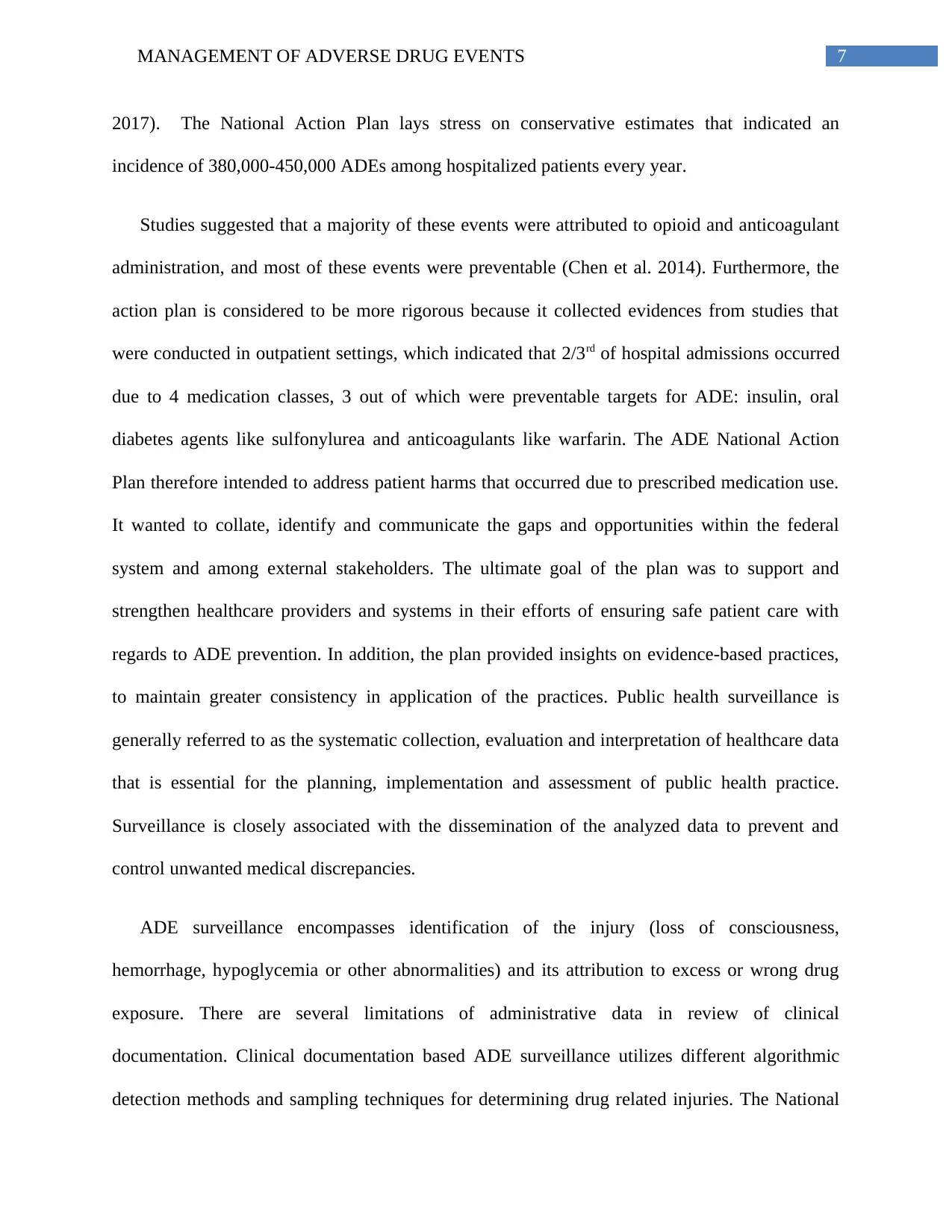
7MANAGEMENT OF ADVERSE DRUG EVENTS
2017). The National Action Plan lays stress on conservative estimates that indicated an
incidence of 380,000-450,000 ADEs among hospitalized patients every year.
Studies suggested that a majority of these events were attributed to opioid and anticoagulant
administration, and most of these events were preventable (Chen et al. 2014). Furthermore, the
action plan is considered to be more rigorous because it collected evidences from studies that
were conducted in outpatient settings, which indicated that 2/3rd of hospital admissions occurred
due to 4 medication classes, 3 out of which were preventable targets for ADE: insulin, oral
diabetes agents like sulfonylurea and anticoagulants like warfarin. The ADE National Action
Plan therefore intended to address patient harms that occurred due to prescribed medication use.
It wanted to collate, identify and communicate the gaps and opportunities within the federal
system and among external stakeholders. The ultimate goal of the plan was to support and
strengthen healthcare providers and systems in their efforts of ensuring safe patient care with
regards to ADE prevention. In addition, the plan provided insights on evidence-based practices,
to maintain greater consistency in application of the practices. Public health surveillance is
generally referred to as the systematic collection, evaluation and interpretation of healthcare data
that is essential for the planning, implementation and assessment of public health practice.
Surveillance is closely associated with the dissemination of the analyzed data to prevent and
control unwanted medical discrepancies.
ADE surveillance encompasses identification of the injury (loss of consciousness,
hemorrhage, hypoglycemia or other abnormalities) and its attribution to excess or wrong drug
exposure. There are several limitations of administrative data in review of clinical
documentation. Clinical documentation based ADE surveillance utilizes different algorithmic
detection methods and sampling techniques for determining drug related injuries. The National
2017). The National Action Plan lays stress on conservative estimates that indicated an
incidence of 380,000-450,000 ADEs among hospitalized patients every year.
Studies suggested that a majority of these events were attributed to opioid and anticoagulant
administration, and most of these events were preventable (Chen et al. 2014). Furthermore, the
action plan is considered to be more rigorous because it collected evidences from studies that
were conducted in outpatient settings, which indicated that 2/3rd of hospital admissions occurred
due to 4 medication classes, 3 out of which were preventable targets for ADE: insulin, oral
diabetes agents like sulfonylurea and anticoagulants like warfarin. The ADE National Action
Plan therefore intended to address patient harms that occurred due to prescribed medication use.
It wanted to collate, identify and communicate the gaps and opportunities within the federal
system and among external stakeholders. The ultimate goal of the plan was to support and
strengthen healthcare providers and systems in their efforts of ensuring safe patient care with
regards to ADE prevention. In addition, the plan provided insights on evidence-based practices,
to maintain greater consistency in application of the practices. Public health surveillance is
generally referred to as the systematic collection, evaluation and interpretation of healthcare data
that is essential for the planning, implementation and assessment of public health practice.
Surveillance is closely associated with the dissemination of the analyzed data to prevent and
control unwanted medical discrepancies.
ADE surveillance encompasses identification of the injury (loss of consciousness,
hemorrhage, hypoglycemia or other abnormalities) and its attribution to excess or wrong drug
exposure. There are several limitations of administrative data in review of clinical
documentation. Clinical documentation based ADE surveillance utilizes different algorithmic
detection methods and sampling techniques for determining drug related injuries. The National
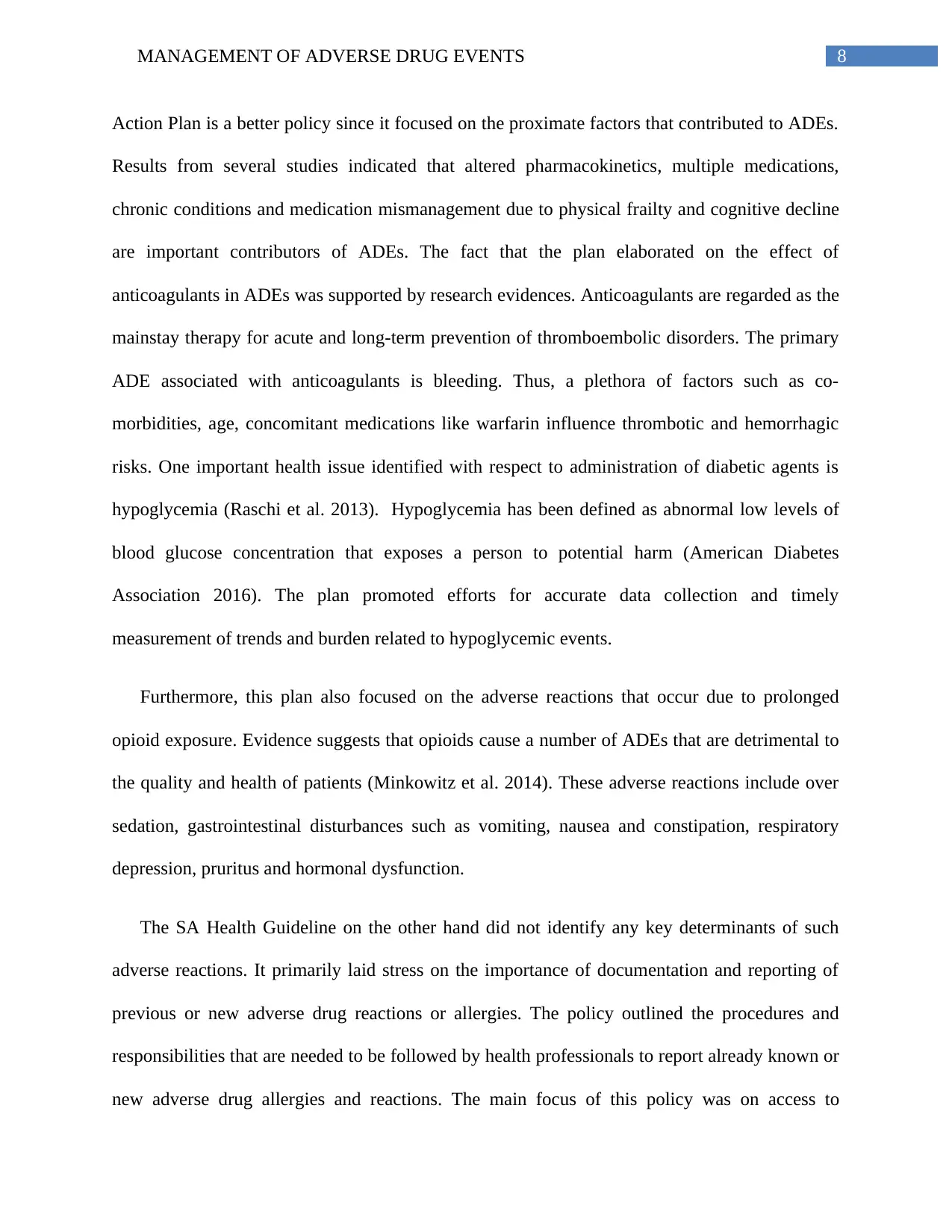
8MANAGEMENT OF ADVERSE DRUG EVENTS
Action Plan is a better policy since it focused on the proximate factors that contributed to ADEs.
Results from several studies indicated that altered pharmacokinetics, multiple medications,
chronic conditions and medication mismanagement due to physical frailty and cognitive decline
are important contributors of ADEs. The fact that the plan elaborated on the effect of
anticoagulants in ADEs was supported by research evidences. Anticoagulants are regarded as the
mainstay therapy for acute and long-term prevention of thromboembolic disorders. The primary
ADE associated with anticoagulants is bleeding. Thus, a plethora of factors such as co-
morbidities, age, concomitant medications like warfarin influence thrombotic and hemorrhagic
risks. One important health issue identified with respect to administration of diabetic agents is
hypoglycemia (Raschi et al. 2013). Hypoglycemia has been defined as abnormal low levels of
blood glucose concentration that exposes a person to potential harm (American Diabetes
Association 2016). The plan promoted efforts for accurate data collection and timely
measurement of trends and burden related to hypoglycemic events.
Furthermore, this plan also focused on the adverse reactions that occur due to prolonged
opioid exposure. Evidence suggests that opioids cause a number of ADEs that are detrimental to
the quality and health of patients (Minkowitz et al. 2014). These adverse reactions include over
sedation, gastrointestinal disturbances such as vomiting, nausea and constipation, respiratory
depression, pruritus and hormonal dysfunction.
The SA Health Guideline on the other hand did not identify any key determinants of such
adverse reactions. It primarily laid stress on the importance of documentation and reporting of
previous or new adverse drug reactions or allergies. The policy outlined the procedures and
responsibilities that are needed to be followed by health professionals to report already known or
new adverse drug allergies and reactions. The main focus of this policy was on access to
Action Plan is a better policy since it focused on the proximate factors that contributed to ADEs.
Results from several studies indicated that altered pharmacokinetics, multiple medications,
chronic conditions and medication mismanagement due to physical frailty and cognitive decline
are important contributors of ADEs. The fact that the plan elaborated on the effect of
anticoagulants in ADEs was supported by research evidences. Anticoagulants are regarded as the
mainstay therapy for acute and long-term prevention of thromboembolic disorders. The primary
ADE associated with anticoagulants is bleeding. Thus, a plethora of factors such as co-
morbidities, age, concomitant medications like warfarin influence thrombotic and hemorrhagic
risks. One important health issue identified with respect to administration of diabetic agents is
hypoglycemia (Raschi et al. 2013). Hypoglycemia has been defined as abnormal low levels of
blood glucose concentration that exposes a person to potential harm (American Diabetes
Association 2016). The plan promoted efforts for accurate data collection and timely
measurement of trends and burden related to hypoglycemic events.
Furthermore, this plan also focused on the adverse reactions that occur due to prolonged
opioid exposure. Evidence suggests that opioids cause a number of ADEs that are detrimental to
the quality and health of patients (Minkowitz et al. 2014). These adverse reactions include over
sedation, gastrointestinal disturbances such as vomiting, nausea and constipation, respiratory
depression, pruritus and hormonal dysfunction.
The SA Health Guideline on the other hand did not identify any key determinants of such
adverse reactions. It primarily laid stress on the importance of documentation and reporting of
previous or new adverse drug reactions or allergies. The policy outlined the procedures and
responsibilities that are needed to be followed by health professionals to report already known or
new adverse drug allergies and reactions. The main focus of this policy was on access to
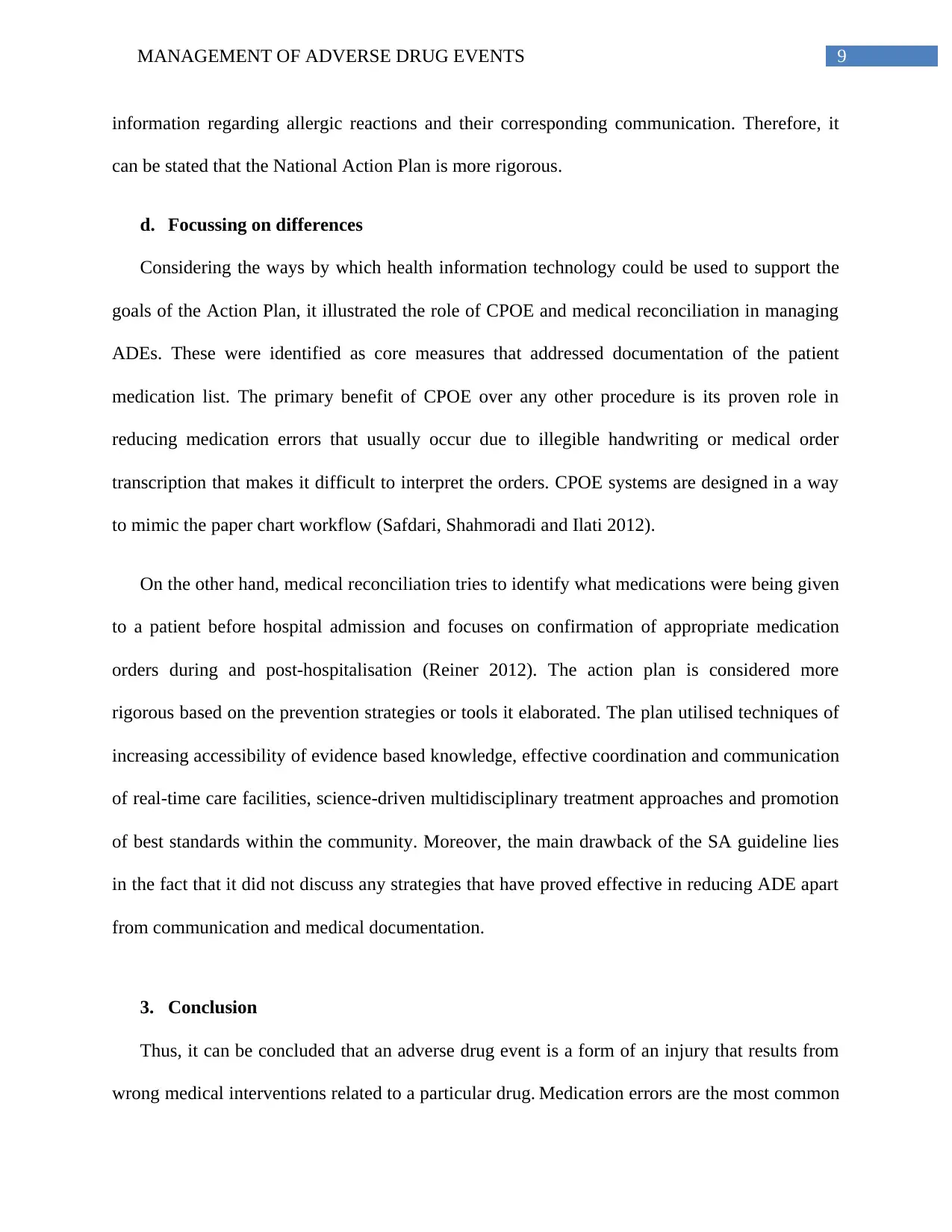
9MANAGEMENT OF ADVERSE DRUG EVENTS
information regarding allergic reactions and their corresponding communication. Therefore, it
can be stated that the National Action Plan is more rigorous.
d. Focussing on differences
Considering the ways by which health information technology could be used to support the
goals of the Action Plan, it illustrated the role of CPOE and medical reconciliation in managing
ADEs. These were identified as core measures that addressed documentation of the patient
medication list. The primary benefit of CPOE over any other procedure is its proven role in
reducing medication errors that usually occur due to illegible handwriting or medical order
transcription that makes it difficult to interpret the orders. CPOE systems are designed in a way
to mimic the paper chart workflow (Safdari, Shahmoradi and Ilati 2012).
On the other hand, medical reconciliation tries to identify what medications were being given
to a patient before hospital admission and focuses on confirmation of appropriate medication
orders during and post-hospitalisation (Reiner 2012). The action plan is considered more
rigorous based on the prevention strategies or tools it elaborated. The plan utilised techniques of
increasing accessibility of evidence based knowledge, effective coordination and communication
of real-time care facilities, science-driven multidisciplinary treatment approaches and promotion
of best standards within the community. Moreover, the main drawback of the SA guideline lies
in the fact that it did not discuss any strategies that have proved effective in reducing ADE apart
from communication and medical documentation.
3. Conclusion
Thus, it can be concluded that an adverse drug event is a form of an injury that results from
wrong medical interventions related to a particular drug. Medication errors are the most common
information regarding allergic reactions and their corresponding communication. Therefore, it
can be stated that the National Action Plan is more rigorous.
d. Focussing on differences
Considering the ways by which health information technology could be used to support the
goals of the Action Plan, it illustrated the role of CPOE and medical reconciliation in managing
ADEs. These were identified as core measures that addressed documentation of the patient
medication list. The primary benefit of CPOE over any other procedure is its proven role in
reducing medication errors that usually occur due to illegible handwriting or medical order
transcription that makes it difficult to interpret the orders. CPOE systems are designed in a way
to mimic the paper chart workflow (Safdari, Shahmoradi and Ilati 2012).
On the other hand, medical reconciliation tries to identify what medications were being given
to a patient before hospital admission and focuses on confirmation of appropriate medication
orders during and post-hospitalisation (Reiner 2012). The action plan is considered more
rigorous based on the prevention strategies or tools it elaborated. The plan utilised techniques of
increasing accessibility of evidence based knowledge, effective coordination and communication
of real-time care facilities, science-driven multidisciplinary treatment approaches and promotion
of best standards within the community. Moreover, the main drawback of the SA guideline lies
in the fact that it did not discuss any strategies that have proved effective in reducing ADE apart
from communication and medical documentation.
3. Conclusion
Thus, it can be concluded that an adverse drug event is a form of an injury that results from
wrong medical interventions related to a particular drug. Medication errors are the most common
Secure Best Marks with AI Grader
Need help grading? Try our AI Grader for instant feedback on your assignments.
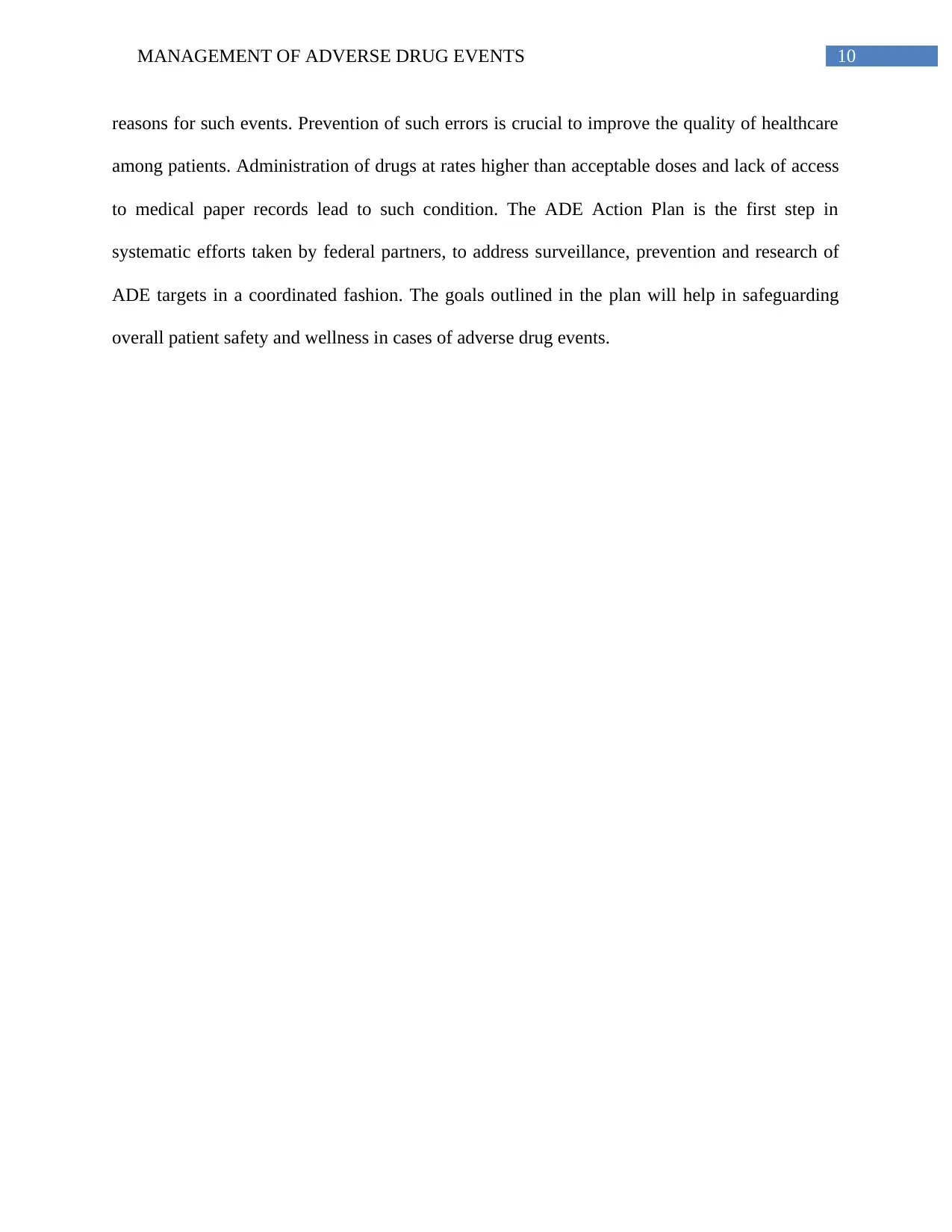
10MANAGEMENT OF ADVERSE DRUG EVENTS
reasons for such events. Prevention of such errors is crucial to improve the quality of healthcare
among patients. Administration of drugs at rates higher than acceptable doses and lack of access
to medical paper records lead to such condition. The ADE Action Plan is the first step in
systematic efforts taken by federal partners, to address surveillance, prevention and research of
ADE targets in a coordinated fashion. The goals outlined in the plan will help in safeguarding
overall patient safety and wellness in cases of adverse drug events.
reasons for such events. Prevention of such errors is crucial to improve the quality of healthcare
among patients. Administration of drugs at rates higher than acceptable doses and lack of access
to medical paper records lead to such condition. The ADE Action Plan is the first step in
systematic efforts taken by federal partners, to address surveillance, prevention and research of
ADE targets in a coordinated fashion. The goals outlined in the plan will help in safeguarding
overall patient safety and wellness in cases of adverse drug events.
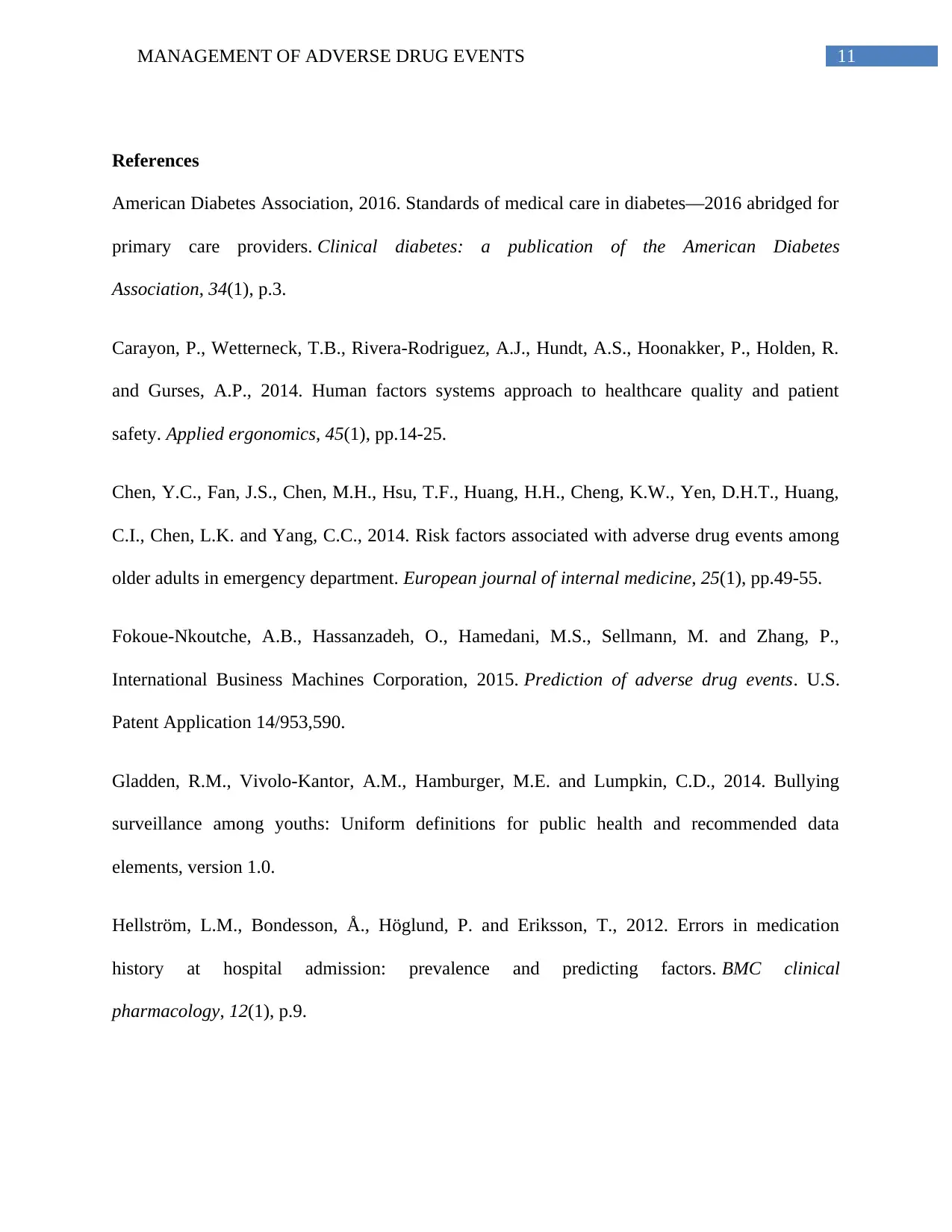
11MANAGEMENT OF ADVERSE DRUG EVENTS
References
American Diabetes Association, 2016. Standards of medical care in diabetes—2016 abridged for
primary care providers. Clinical diabetes: a publication of the American Diabetes
Association, 34(1), p.3.
Carayon, P., Wetterneck, T.B., Rivera-Rodriguez, A.J., Hundt, A.S., Hoonakker, P., Holden, R.
and Gurses, A.P., 2014. Human factors systems approach to healthcare quality and patient
safety. Applied ergonomics, 45(1), pp.14-25.
Chen, Y.C., Fan, J.S., Chen, M.H., Hsu, T.F., Huang, H.H., Cheng, K.W., Yen, D.H.T., Huang,
C.I., Chen, L.K. and Yang, C.C., 2014. Risk factors associated with adverse drug events among
older adults in emergency department. European journal of internal medicine, 25(1), pp.49-55.
Fokoue-Nkoutche, A.B., Hassanzadeh, O., Hamedani, M.S., Sellmann, M. and Zhang, P.,
International Business Machines Corporation, 2015. Prediction of adverse drug events. U.S.
Patent Application 14/953,590.
Gladden, R.M., Vivolo-Kantor, A.M., Hamburger, M.E. and Lumpkin, C.D., 2014. Bullying
surveillance among youths: Uniform definitions for public health and recommended data
elements, version 1.0.
Hellström, L.M., Bondesson, Å., Höglund, P. and Eriksson, T., 2012. Errors in medication
history at hospital admission: prevalence and predicting factors. BMC clinical
pharmacology, 12(1), p.9.
References
American Diabetes Association, 2016. Standards of medical care in diabetes—2016 abridged for
primary care providers. Clinical diabetes: a publication of the American Diabetes
Association, 34(1), p.3.
Carayon, P., Wetterneck, T.B., Rivera-Rodriguez, A.J., Hundt, A.S., Hoonakker, P., Holden, R.
and Gurses, A.P., 2014. Human factors systems approach to healthcare quality and patient
safety. Applied ergonomics, 45(1), pp.14-25.
Chen, Y.C., Fan, J.S., Chen, M.H., Hsu, T.F., Huang, H.H., Cheng, K.W., Yen, D.H.T., Huang,
C.I., Chen, L.K. and Yang, C.C., 2014. Risk factors associated with adverse drug events among
older adults in emergency department. European journal of internal medicine, 25(1), pp.49-55.
Fokoue-Nkoutche, A.B., Hassanzadeh, O., Hamedani, M.S., Sellmann, M. and Zhang, P.,
International Business Machines Corporation, 2015. Prediction of adverse drug events. U.S.
Patent Application 14/953,590.
Gladden, R.M., Vivolo-Kantor, A.M., Hamburger, M.E. and Lumpkin, C.D., 2014. Bullying
surveillance among youths: Uniform definitions for public health and recommended data
elements, version 1.0.
Hellström, L.M., Bondesson, Å., Höglund, P. and Eriksson, T., 2012. Errors in medication
history at hospital admission: prevalence and predicting factors. BMC clinical
pharmacology, 12(1), p.9.
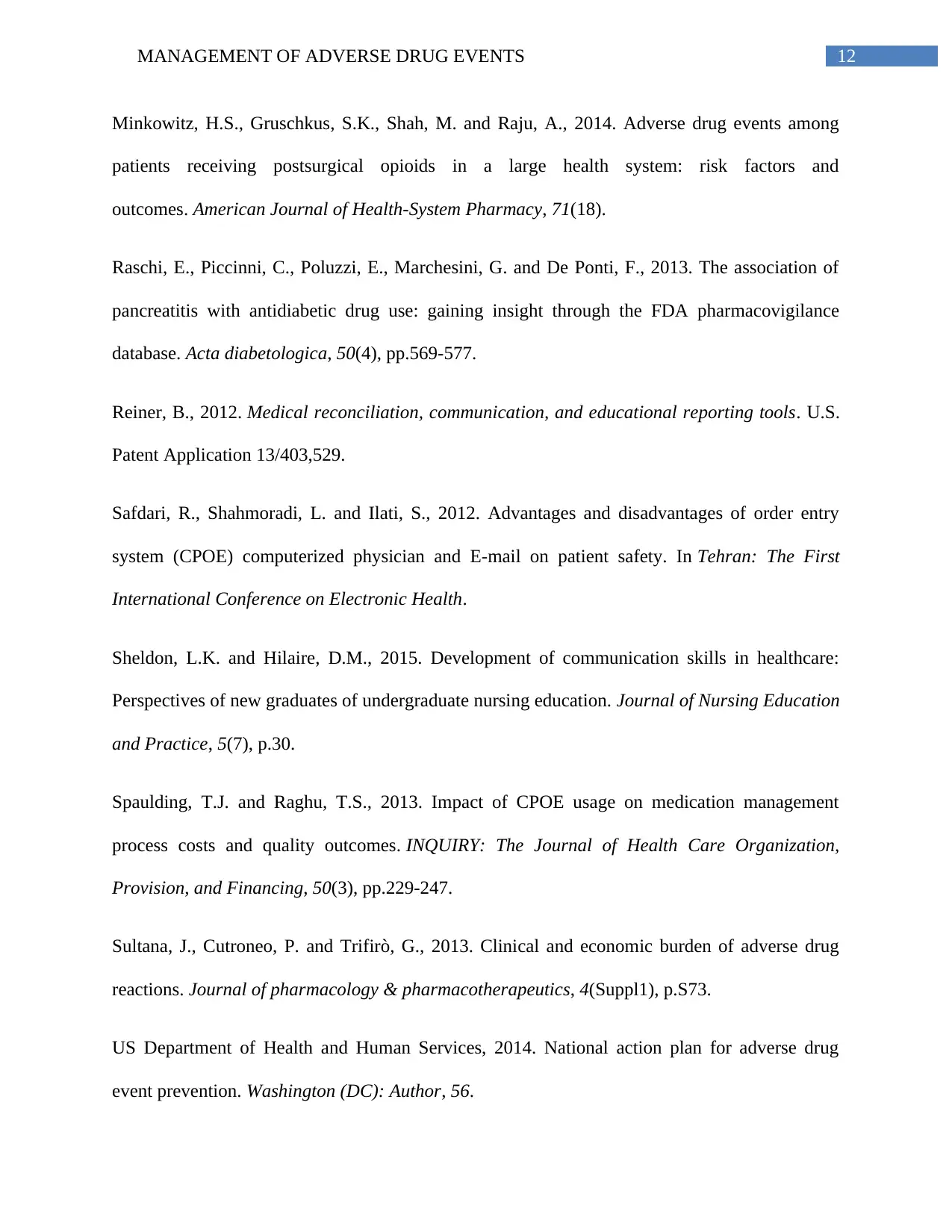
12MANAGEMENT OF ADVERSE DRUG EVENTS
Minkowitz, H.S., Gruschkus, S.K., Shah, M. and Raju, A., 2014. Adverse drug events among
patients receiving postsurgical opioids in a large health system: risk factors and
outcomes. American Journal of Health-System Pharmacy, 71(18).
Raschi, E., Piccinni, C., Poluzzi, E., Marchesini, G. and De Ponti, F., 2013. The association of
pancreatitis with antidiabetic drug use: gaining insight through the FDA pharmacovigilance
database. Acta diabetologica, 50(4), pp.569-577.
Reiner, B., 2012. Medical reconciliation, communication, and educational reporting tools. U.S.
Patent Application 13/403,529.
Safdari, R., Shahmoradi, L. and Ilati, S., 2012. Advantages and disadvantages of order entry
system (CPOE) computerized physician and E-mail on patient safety. In Tehran: The First
International Conference on Electronic Health.
Sheldon, L.K. and Hilaire, D.M., 2015. Development of communication skills in healthcare:
Perspectives of new graduates of undergraduate nursing education. Journal of Nursing Education
and Practice, 5(7), p.30.
Spaulding, T.J. and Raghu, T.S., 2013. Impact of CPOE usage on medication management
process costs and quality outcomes. INQUIRY: The Journal of Health Care Organization,
Provision, and Financing, 50(3), pp.229-247.
Sultana, J., Cutroneo, P. and Trifirò, G., 2013. Clinical and economic burden of adverse drug
reactions. Journal of pharmacology & pharmacotherapeutics, 4(Suppl1), p.S73.
US Department of Health and Human Services, 2014. National action plan for adverse drug
event prevention. Washington (DC): Author, 56.
Minkowitz, H.S., Gruschkus, S.K., Shah, M. and Raju, A., 2014. Adverse drug events among
patients receiving postsurgical opioids in a large health system: risk factors and
outcomes. American Journal of Health-System Pharmacy, 71(18).
Raschi, E., Piccinni, C., Poluzzi, E., Marchesini, G. and De Ponti, F., 2013. The association of
pancreatitis with antidiabetic drug use: gaining insight through the FDA pharmacovigilance
database. Acta diabetologica, 50(4), pp.569-577.
Reiner, B., 2012. Medical reconciliation, communication, and educational reporting tools. U.S.
Patent Application 13/403,529.
Safdari, R., Shahmoradi, L. and Ilati, S., 2012. Advantages and disadvantages of order entry
system (CPOE) computerized physician and E-mail on patient safety. In Tehran: The First
International Conference on Electronic Health.
Sheldon, L.K. and Hilaire, D.M., 2015. Development of communication skills in healthcare:
Perspectives of new graduates of undergraduate nursing education. Journal of Nursing Education
and Practice, 5(7), p.30.
Spaulding, T.J. and Raghu, T.S., 2013. Impact of CPOE usage on medication management
process costs and quality outcomes. INQUIRY: The Journal of Health Care Organization,
Provision, and Financing, 50(3), pp.229-247.
Sultana, J., Cutroneo, P. and Trifirò, G., 2013. Clinical and economic burden of adverse drug
reactions. Journal of pharmacology & pharmacotherapeutics, 4(Suppl1), p.S73.
US Department of Health and Human Services, 2014. National action plan for adverse drug
event prevention. Washington (DC): Author, 56.
Paraphrase This Document
Need a fresh take? Get an instant paraphrase of this document with our AI Paraphraser
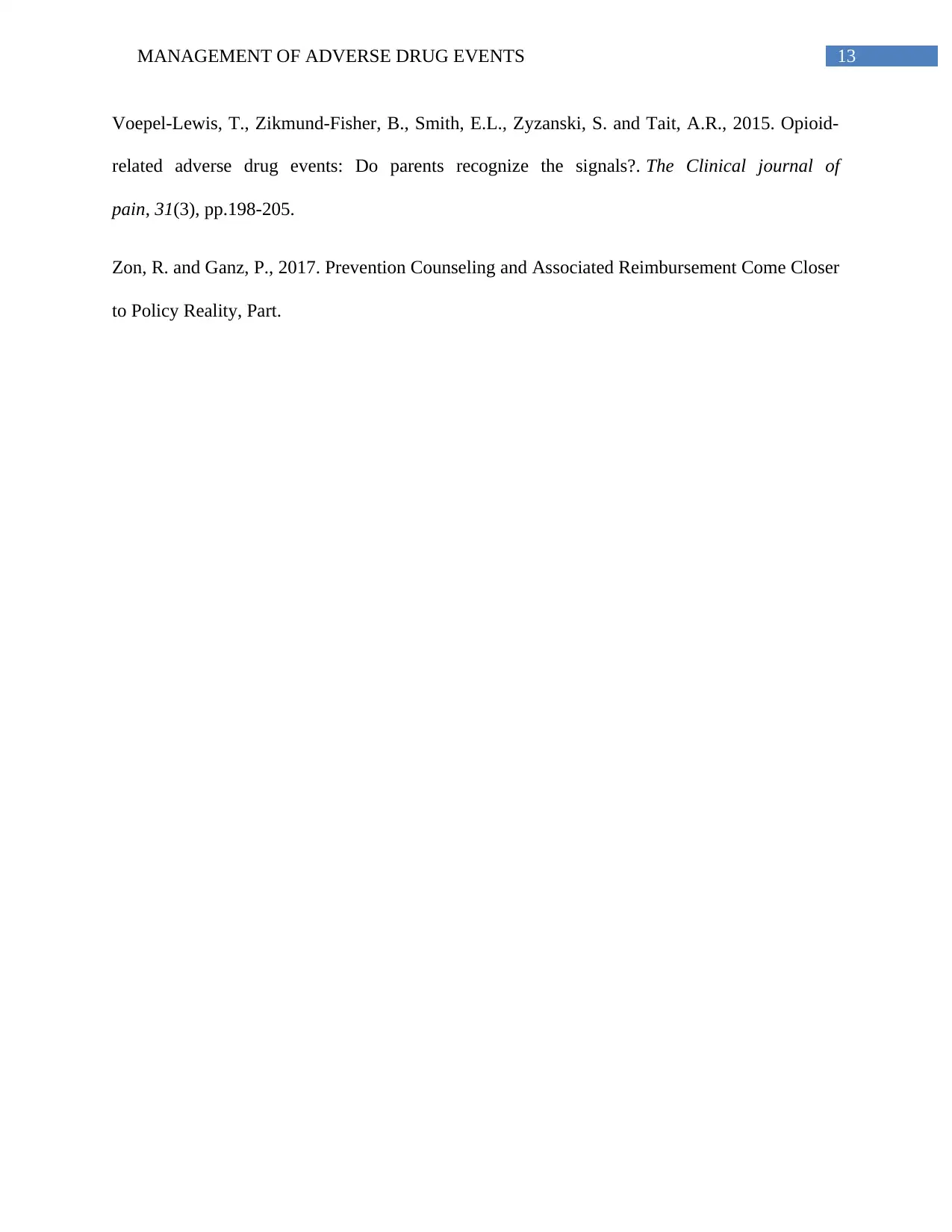
13MANAGEMENT OF ADVERSE DRUG EVENTS
Voepel-Lewis, T., Zikmund-Fisher, B., Smith, E.L., Zyzanski, S. and Tait, A.R., 2015. Opioid-
related adverse drug events: Do parents recognize the signals?. The Clinical journal of
pain, 31(3), pp.198-205.
Zon, R. and Ganz, P., 2017. Prevention Counseling and Associated Reimbursement Come Closer
to Policy Reality, Part.
Voepel-Lewis, T., Zikmund-Fisher, B., Smith, E.L., Zyzanski, S. and Tait, A.R., 2015. Opioid-
related adverse drug events: Do parents recognize the signals?. The Clinical journal of
pain, 31(3), pp.198-205.
Zon, R. and Ganz, P., 2017. Prevention Counseling and Associated Reimbursement Come Closer
to Policy Reality, Part.
1 out of 14
Related Documents
Your All-in-One AI-Powered Toolkit for Academic Success.
+13062052269
info@desklib.com
Available 24*7 on WhatsApp / Email
![[object Object]](/_next/static/media/star-bottom.7253800d.svg)
Unlock your academic potential
© 2024 | Zucol Services PVT LTD | All rights reserved.





